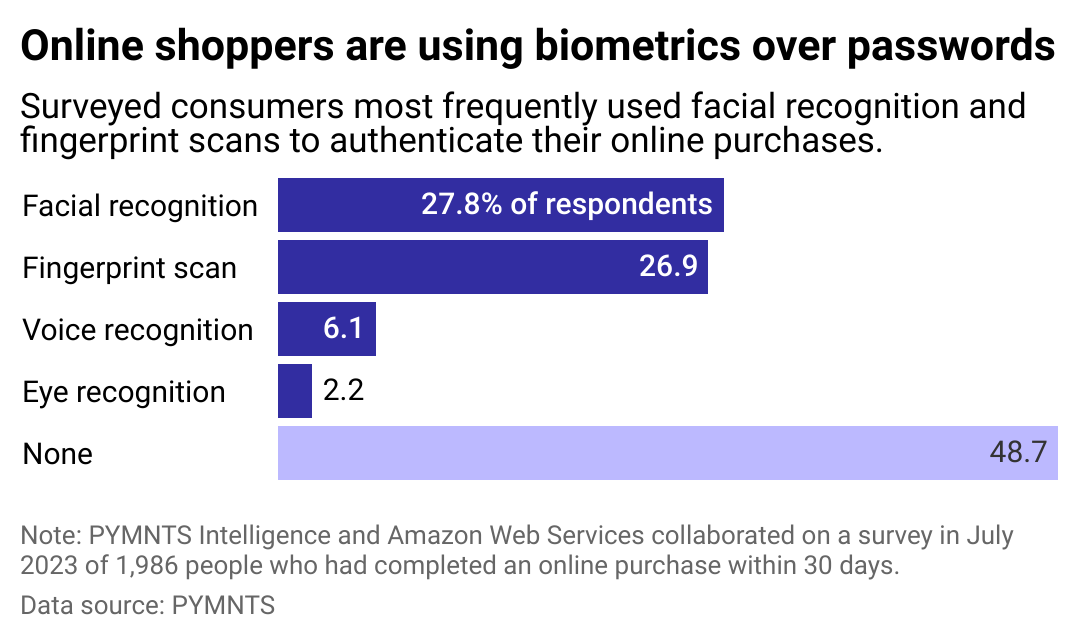Smartphones unlocking at a glance. Palm payments for in-store shopping. Eye scans to pass through airport security.
What were once sci-fi fantasies are now a reality. Biometrics such as fingerprints, eye scans, facial recognition, and voice matching don't exist just for use by the wealthy; they are incorporated into everyday technology and used by millions of people across the globe every day.
To get a more comprehensive look at the state of biometric technologies today, Spokeo took a closer look at their adoption and public opinion on various use cases, citing studies, surveys, and news coverage of the growing trend.
Most commonly, biometrics are used for identity verification, accessing devices or accounts, and making purchases. But this year is poised to see surges in biometrics elsewhere, such as at airports, to speed up security screenings and boarding.
More public uses of this technology present privacy concerns, as it's increasingly difficult for people to avoid having their biometric data captured and stored. Consumers may choose not to utilize biometrics on their own devices, but avoiding it can be impossible when government agencies, companies, and law enforcement use facial recognition in public and private spaces.

American views on biometrics use vary widely based on use cases and type of data. However, people tend to become more comfortable with technology the more they are exposed to it or use it in their daily lives. At its best, biometrics offer faster logins, better security, and greater accuracy than other authentication methods. The information is unique, universal, easy to store, and difficult to forge. Biometrics offer more streamlined authorization, eliminating the need to remember dozens of passwords—and the danger of password sharing across accounts.
Biometric technology hit the shelves in late 2011 with the release of Android's then-latest operating system, which let users unlock their screens using facial recognition. Apple incorporated fingerprint technology with its iPhone 5S in 2013 and later added facial recognition with the iPhone X in 2017. Today, about 4 in 5 smartphone users have biometric scan options enabled on their devices, according to a 2022 report by Cisco Duo.
With the growth of mobile shopping and digital wallets, people also use biometrics to complete transactions more frequently. Insider Intelligence eMarketer expects mobile sales to reach $558.29 billion this year, and to comprise more than 7% of total retail sales nationwide.
A PYMNTS Intelligence and Amazon Web Services report released in September 2023 found that over half of consumers who bought something online within a month-long period used biometric authentication to complete the transaction, primarily with facial or fingerprint scans.
Biometrics have become a part of in-store shopping, as well. In 2023, Amazon installed its Amazon One palm scan technology in all 500-plus Whole Foods Market stores. The technology is also present in its Amazon Go physical stores. The in-store hand scanners are much less popular among the masses, being relatively new and less ubiquitous than mobile phone usage. In other areas of the world, options are expanding for in-store biometric payments.
About 3 in 4 Americans are not comfortable using the hand recognition technology to make payments, according to a 2023 survey by CivicScience. Fewer than half of U.S. consumers said they would utilize palm-scanning payment devices if various retail stores installed them, including Kroger and Costco. However, a Pew Research study conducted in 2021 indicated half of Americans favored retail stores using facial recognition to enhance the security of credit cards by confirming account holder identities at checkout.
In mid-2023, the Federal Trade Commission warned the increasing use of biometric technologies raises significant concerns for consumer privacy, data security, bias, and discrimination.
Despite several attempts by lawmakers over the past few years, the U.S. hasn't created national data privacy and cybersecurity regulations, leaving the handling of biometrics and other personal data at the mercy of state and local governments and private companies. A few states have adopted laws regulating private entities' collection and use of biometric information, and several others have introduced bills with similar goals that are still moving through the legislative process.
GetApp's biannual survey of around 1,000 American online shoppers found that trust in tech companies' handling of biometric data is declining. People are increasingly concerned about biometric data misuse, breaches, identity theft, privacy, and inaccuracy, according to the 2024 survey.
Concern is also mounting among human rights groups over facial recognition surveillance in public spaces, saying this type of mass surveillance undermines rights to privacy and nondiscrimination and threatens freedoms of assembly and expression. Historically, these technologies have struggled to recognize and distinguish among people of certain races, ethnicities, and genders, so there is an even greater risk of discrimination in using them to surveil already marginalized communities.
This issue presents a more significant concern when applied to policing. As of 2021, dozens of federal agencies that employ law enforcement officers used facial recognition technology. Within the Departments of Homeland Security and Justice, seven law enforcement agencies said they used facial recognition services in 2023. Pew Research in 2021 found that a majority of Americans believe police would use facial recognition to find more missing persons and solve crimes faster and more efficiently, but 2 in 3 also agreed that police would use this tech to over-surveil Black and Hispanic neighborhoods.
In November 2023, more than 180 groups signed a statement to stop facial recognition surveillance, with the Human Rights Watch suggesting the world is at a "fork in the road" when it comes to how government agencies will choose to proceed.
Story editing by Ashleigh Graf. Copy editing by Kristen Wegrzyn.
This story originally appeared on Spokeo and was produced and distributed in partnership with Stacker Studio.